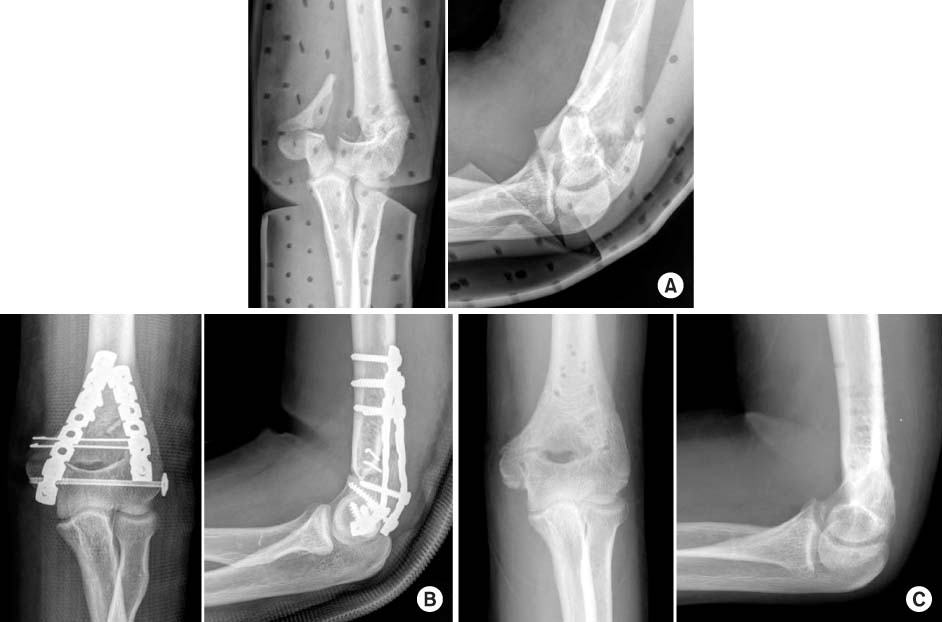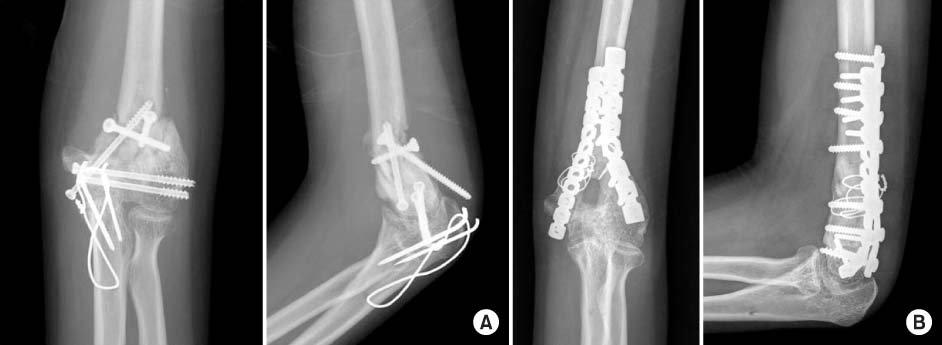J Korean Fract Soc.
2013 Oct;26(4):254-260. 10.12671/jkfs.2013.26.4.254.
Posterior-Posterior Dual Plates Fixation for the Distal Humerus Fractures
- Affiliations
-
- 1Department of Orthopedic Surgery, Yeouido St. Mary's Hospital, The Catholic University of Korea School of Medicine, Seoul, Korea. sw.song@catholic.ac.kr
- 2Department of Orthopedic Surgery, Uijeongbu St. Mary's Hospital, The Catholic University of Korea School of Medicine, Korea.
- KMID: 2183825
- DOI: http://doi.org/10.12671/jkfs.2013.26.4.254
Abstract
- PURPOSE
Fractures of the distal humerus are one of the challenging injuries due to its complex anatomy and accompanied comminution. For dual plate fixation, orthogonal or parallel plating is widely used, but the better of the two is debatable. The purpose of this study was to report another fixation technique that yielded good clinical results with early bone union of distal humerus fracture, namely, posterior-posterior plate fixation.
MATERIALS AND METHODS
From March 2003 to March 2012, 20 patients with distal humerus fractures were treated by posterior-posterior plate fixation. The triceps reflecting approach was used with anterior transposition of the ulnar nerve. The mean age at the time of injury was 45 years (range, 26 to 78 years). By AO classification of distal humerus fractures, there were one case of A2 and B3 respectively, two cases of each A3, C1 and C3, and twelve cases of C2.
RESULTS
The mean period of complete bone union was 7.1 weeks (range, 4 to 11 weeks). The mean flexion-extension range of motion of the elbow joint at last follow-up was 116.2 degrees. The mean pronation was 81.2 degrees and supination was 83.1 degrees. Plates and screws were removed at about nine months after the initial surgery. No cases showed complications or required additional operation.
CONCLUSION
Posterior-posterior dual plates fixation resulted in stable bicortical screw fixation, and insertion of lag screws were possible without interference. Posterior-posterior plating could be an easy and stable fixation method that provides good clinical results.
MeSH Terms
Figure
Reference
-
1. Abzug JM, Dantuluri PK. Use of orthogonal or parallel plating techniques to treat distal humerus fractures. Hand Clin. 2010; 26:411–421.
Article2. Arnander MW, Reeves A, MacLeod IA, Pinto TM, Khaleel A. A biomechanical comparison of plate configuration in distal humerus fractures. J Orthop Trauma. 2008; 22:332–336.
Article3. Jupiter JB, Neff U, Holzach P, Allgöwer M. Intercondylar fractures of the humerus. An operative approach. J Bone Joint Surg Am. 1985; 67:226–239.
Article4. Koonce RC, Baldini TH, Morgan SJ. Are conventional reconstruction plates equivalent to precontoured locking plates for distal humerus fracture fixation? A biomechanics cadaver study. Clin Biomech (Bristol, Avon). 2012; 27:697–701.
Article5. Korner J, Diederichs G, Arzdorf M, et al. A biomechanical evaluation of methods of distal humerus fracture fixation using locking compression plates versus conventional reconstruction plates. J Orthop Trauma. 2004; 18:286–293.
Article6. Korner J, Lill H, Müller LP, Rommens PM, Schneider E, Linke B. The LCP-concept in the operative treatment of distal humerus fractures-biological, biomechanical and surgical aspects. Injury. 2003; 34:Suppl 2. B20–B30.7. Muller ME. The comprehensive classification of fractures of long bones. In : Muller ME, Allgower M, Schneider R, Willenegger H, editors. Manual of internal fixation: techniques recommended by the AO-ASIF Group. 3rd ed. Berlin: Springer-Verlag;1991. p. 150–188.8. O'Driscoll SW. Optimizing stability in distal humeral fracture fixation. J Shoulder Elbow Surg. 2005; 14:186S–194S.9. O'Driscoll SW. Parallel plate fixation of bicolumn distal humeral fractures. Instr Course Lect. 2009; 58:521–528.10. Sanchez-Sotelo J, Torchia ME, O'Driscoll SW. Complex distal humeral fractures: internal fixation with a principle-based parallel-plate technique. J Bone Joint Surg Am. 2007; 89:961–969.11. Schemitsch EH, Tencer AF, Henley MB. Biomechanical evaluation of methods of internal fixation of the distal humerus. J Orthop Trauma. 1994; 8:468–475.
Article12. Self J, Viegas SF, Buford WL Jr, Patterson RM. A comparison of double-plate fixation methods for complex distal humerus fractures. J Shoulder Elbow Surg. 1995; 4:10–16.
Article13. Shin SJ, Sohn HS, Do NH. A clinical comparison of two different double plating methods for intraarticular distal humerus fractures. J Shoulder Elbow Surg. 2010; 19:2–9.
Article14. Stoffel K, Cunneen S, Morgan R, Nicholls R, Stachowiak G. Comparative stability of perpendicular versus parallel double-locking plating systems in osteoporotic comminuted distal humerus fractures. J Orthop Res. 2008; 26:778–784.
Article15. Throckmorton TW, Zarkadas PC, Steinmann SP. Distal humerus fractures. Hand Clin. 2007; 23:457–469.
Article16. Zalavras CG, Vercillo MT, Jun BJ, Otarodifard K, Itamura JM, Lee TQ. Biomechanical evaluation of parallel versus orthogonal plate fixation of intra-articular distal humerus fractures. J Shoulder Elbow Surg. 2011; 20:12–20.
Article
- Full Text Links
- Actions
-
Cited
- CITED
-
- Close
- Share
- Similar articles
-
- Surgical Treatment Strategy for Distal Humerus Intra-articular Fractures
- Orthogonal versus Parallel Plating for Distal Humeral Fractures
- Posterior Dual Plating for Distal Shaft Fractures of the Humerus
- Plain Radiograph Analysis of the Distal Humerus Posterior Bowing That May Affect Interlocking Intramedullary Nailing for Humerus Shaft Fracture
- Ulnar Nerve Injury Caused by the Incomplete Insertion of a Screw Head after Internal Fixation with Dual Locking Plates in AO/OTA Type C2 Distal Humerus Fractures



